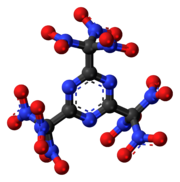2,4,6-Tris(trinitromethyl)-1,3,5-triazine
 |
|
 |
|
| Names | |
|---|---|
|
IUPAC name
2,4,6-Tris(trinitromethyl)-1,3,5-triazine
|
|
| Identifiers | |
|
3D model (JSmol)
|
|
| ChemSpider | |
|
|
|
|
| Properties | |
| C6N12O18 | |
| Molar mass | 528.13 g·mol−1 |
| Density | 1.91 g/cm3 |
| Melting point | 91 to 92 °C (196 to 198 °F; 364 to 365 K) |
| Related compounds | |
|
Related compounds
|
4,4’-Dinitro-3,3’-diazenofuroxan Hexanitrohexaazaisowurtzitane Heptanitrocubane Octanitrocubane |
|
Except where otherwise noted, data are given for materials in their standard state (at 25 °C [77 °F], 100 kPa).
|
|
|
|
|
| Infobox references | |
2,4,6-Tris(trinitromethyl)-1,3,5-triazine is a chemical compound that is a derivative of triazine first prepared in 1995. It is synthesized by destructive nitration of 2,4,6-tricarboxyl-1,3,5-triazine. It is noteworthy for having more nitro groups than it does carbon atoms, so could be used as an oxygen source, or added to oxygen-poor explosives to increase their power.
Derivatives have been prepared by nucleophilic displacement of the nitro groups with azide and hydrazine.
...
Wikipedia
